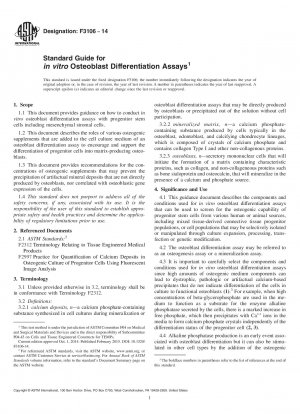ASTM F3106-14
Standard Guide for in vitro Osteoblast Differentiation Assays
- Standard No.
- ASTM F3106-14
- Release Date
- 2014
- Published By
- American Society for Testing and Materials (ASTM)
- Status
- Replace By
- ASTM F3106-22
- Latest
- ASTM F3106-22
- Scope
4.1 This guidance document describes the components and conditions used for in vitro osteoblast differentiation assays that can be used to screen for the osteogenic capability of progenitor stem cells from various human or animal sources, including mixed tissue-derived connective tissue progenitor populations, or cell populations that may be selectively isolated or manipulated through culture expansion, processing, transfection or genetic modification.
4.2 The osteoblast differentiation assay may be referred to as an osteogenesis assay or a mineralization assay.
4.3 It is important to carefully select the components and conditions used for in vitro osteoblast differentiation assays since high amounts of osteogenic medium components can lead to dystrophic, pathologic or artifactual calcium-based precipitates that do not indicate differentiation of the cells in culture to functional osteoblasts (1).3 For example, when high concentrations of beta-glycerophosphate are used in the medium to function as a substrate for the enzyme alkaline phosphatase secreted by the cells, there is a marked increase in free phosphate, which then precipitates with Ca++ ions in the media to form calcium phosphate crystals independently of the differentiation status of the progenitor cell (2, 3).
4.4 Alkaline phosphatase production is an early event associated with osteoblast differentiation but it can also be stimulated in other cell types by the addition of the osteogenic supplement dexamethasone to the medium. Alkaline phosphatase enhances the formation of calcified deposits prior to their natural occurrence in bone that typically coincides with bone sialoprotein and osteocalcin expression by mineralized matrix-producing osteoblasts. These kinds of calcified/mineral deposits are thus considered dystrophic, pathologic, or artifactual because they were not initiated by a mature osteoblast. A calcium measurement, such as that described in Practice F2997 for the Quantification of Calcium Deposits in Osteogenic Culture of Progenitor Cells Using Fluorescent Image Analysis, may thus result in a potentially false interpretation of the differentiation status of osteoprogenitor cells if used in isolation without gene or protein expression data.
4.5 In addition to screening for multipotentiality of undifferentiated stem cells, osteoblast differentiation assays are useful for assessing the osteoinductivity of cell culture substrates or biomaterial scaffolds or drugs or biomolecules; such as, cytokines or growth factors.
4.6 In vitro osteoblast differentiation assays are not predictive of in vivo bone formation, but are useful for comparison purposes to standard......
ASTM F3106-14 Referenced Document
- ASTM F2312 Standard Terminology Relating to Tissue Engineered Medical Products
- ASTM F2997 Standard Practice for Quantification of Calcium Deposits in Osteogenic Culture of Progenitor Cells Using Fluorescent Image Analysis*, 2024-04-20 Update
ASTM F3106-14 history
- 2022 ASTM F3106-22 Standard Guide for
in vitro Osteoblast Differentiation Assays - 2014 ASTM F3106-14 Standard Guide for
in vitro Osteoblast Differentiation Assays

Copyright ©2024 All Rights Reserved